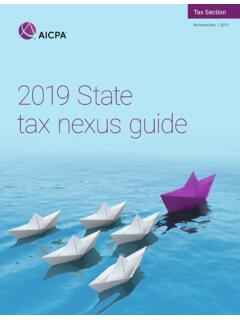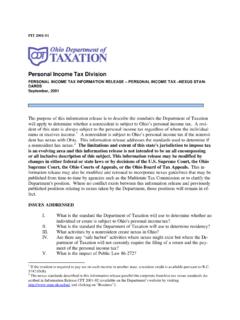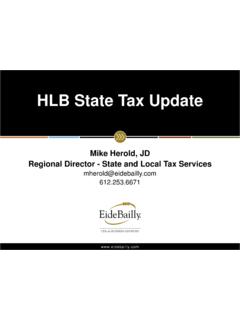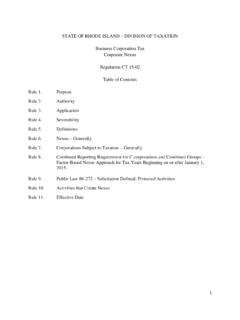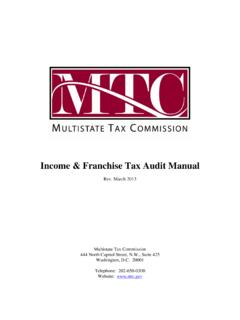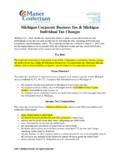Transcription of UNIQUE CONSIDERATIONS FOR STATE …
1 Page 1 of 95 2014 AICPA, Inc. UNIQUE CONSIDERATIONS FOR STATE BUSINESS TAX RETURNS Introduction This guide provides practitioners some of the information they should consider when preparing business STATE income tax returns. The laws, regulations and policies of each STATE should be verified for application to specific cases. This guide is neither authoritative nor all-inclusive and should not be relied upon for a specific taxpayer. Practitioners need to research issues identified in this Acknowledgements The STATE and Local Tax Practice Guides were developed and updated by the STATE and Local Taxation Technical Resource Panel (SALT TRP) of the Tax Division of the American Institute of Certified Public Accountants. 2013-2014 SALT TRP Sarah McGahan, Chair Jamie C. Yesnowitz, Immediate Past Chair Merrill Barter Catherine Shaw Stanton Cynthia McKinney Jennifer Jensen Steve Byrne Craig Ridenour Patrick Johnson Minde King Joe Garrett, Jr.
2 Eileen Sherr, AICPA Sr. Technical Manager & Staff Liaison Page 2 of 95 2014 AICPA, Inc. Table of Contents STATE Page ALABAMA .. 3 ALASKA .. 5 ARIZONA .. 6 ARKANSAS .. 9 CALIFORNIA .. 11 COLORADO .. 12 CONNECTICUT .. 15 DELAWARE .. 17 DISTRICT OF 18 20 GEORGIA .. 22 HAW AII .. 24 IDAHO .. 25 ILLINOIS .. 27 28 IOWA .. 31 32 KENTUCKY .. 35 LOUISIANA .. 37 MAINE .. 39 MARYLAND .. 40 MASSACHUSETTS .. 42 MICHIGAN .. 45 MINNESOTA .. 46 MISSISSIPPI .. 48 MISSOURI .. 50 MONTANA .. 51 NEBRASKA .. 54 NEVADA .. 56 NEW HAMPSHIRE .. 57 NEW JERSEY .. 58 NEW MEXICO .. 61 NEW YORK .. 63 NORTH CAROLINA .. 68 NORTH DAKOTA .. 69 OHIO .. 71 OKLAHOMA .. 73 OREGON .. 76 PENNSYLVANIA .. 77 RHODE ISLAND .. 78 SOUTH CAROLINA .. 81 SOUTH DAKOTA .. 82 TENNESSEE .. 82 TEXAS .. 84 UTAH .. 87 VERMONT .. 89 VIRGINIA .. 89 WASHINGTON .. 91 WEST VIRGINIA .. 92 WISCONSIN .. 94 WYOMING .. 95 Page 3 of 95 2014 AICPA, Inc. ALABAMA (AL) 1. UNIQUE nexus rules AL has an economic nexus position for banks/financial institutions.
3 The excise tax is levied on banks/financial institutions that issue credit cards to AL residents or businesses. 2. Tax Base Adjustments AL s starting point for determining AL taxable income is federal taxable income after net operating loss (NOL) and special deductions ( , line 30). AL did not follow the depreciation changes enacted by the Economic Stimulus Act (ESA) of 2008 (2008 only). This is in contrast to the STATE s decision to follow the federal rules for computing the additional depreciation deduction provided under the Job Creation and Workers Assistance Act (JCWAA) of 2002 and Jobs and Growth Tax Relief Reconciliation Act (JGTRRA) of 2003. AL does allow the additional 30% depreciation deduction (2002 Act) and the additional 50% depreciation deduction (2003 Act) on certain types of assets as outlined in the economic stimulus bill. AL also follows the additional 50% bonus depreciation rules in 2009.
4 AL allows a federal income tax deduction for tax paid or accrued. AL does not allow NOL carryback. Losses may be carried forward for 15 years (16 years in the case of a corporation that was prevented from utilizing a NOL in tax year 2001 due to the NOL suspension, but only to the extent the 2001 NOL was denied). The AL net operating loss is limited to net operating losses incurred by a corporation that did business in AL and filed AL returns in prior loss years. 3. Allocation and Apportionment For corporate entities, the sales factor includes the gross proceeds from the sale of fixed assets, rather than the gain/loss on the sale of fixed assets, if the sale produces business income and was in the regular course of business. AL adopts the federal treatment of capital losses and gains through AL s starting point, federal taxable income. Capital loss carry backs must be reported to AL by filing an amended return, but the statute of limitations must not be closed on the taxes paid for the tax year in which the capital loss is carried.
5 If the statute has closed for that tax year, no refund can be obtained even if within three years from when the capital loss arose. For tax years beginning on or after Dec. 31, 2010, AL enacted apportionment factor changes. In determining the AL apportionment factor, the sales must be double weighted. In addition, AL has adopted market-based sourcing for service and intangible receipts. Receipts that cannot be sourced based on market sourcing will be thrown out of the sales factor. Form 20-C, Schedule D-1, is used to apportion income to AL. Negative amounts are strictly prohibited from use on this schedule. Page 4 of 95 2014 AICPA, Inc. 4. Payment and Filing Requirements Taxpayers are required to make payments in excess of $750 by use of electronic funds transfer. Others may elect this method. Taxpayers must register prior to making electronic payments. AL requires all corporations and limited liability entities to file the AL business privilege tax return.
6 For corporations, the annual return is due no later than two and one-half months after the beginning of a taxpayer s taxable year (March 15 if the entity has a Dec. 31 year end), and for limited liability entities, three and one-half (April 15 if the entity has a Dec. 31 year end). For disregarded entities, the annual return is due no later than the time its owner is required to file. A disregarded entity that is owned by an individual, general partnership or other entity that is not subject to the tax must file a return and pay the tax. Members of a financial institution group can elect to file a consolidated business privilege tax return. An electing family limited liability entity s tax is limited to $500 if page 1 of Form PPT is signed and Schedule BPT-E is attached to Form PPT. A single member LLC that is treated as a disregarded entity for federal income tax purposes does not qualify as an electing family limited liability entity.
7 Banks and other financial institutions pay an excise tax rather than the corporation income tax. Consolidated returns may be filed; however, a filing fee applies. The election to file a consolidated excise tax return is an annual election. In general, AL requires that corporations file income tax returns on a separate company basis. Each corporation, even if a member of a commonly controlled group of corporations, must compute its income and apportionment factor as if it were a separate economic entity. However, affiliated corporations may elect to file an AL nexus consolidated return (consolidated filing fee applies). Each member of the AL consolidated group must independently have nexus with AL and compute its income and apportionment factor on a separate entity basis. This group may not include corporations subject to the insurance premium license tax or the financial institution excise tax.
8 Nothing in the aforementioned consolidated filing provisions shall be construed as allowing or requiring the filing of a combined tax report by unitary businesses. 5. Credits Tax incentives are available for AL taxpayers. These incentives include: income tax capital credit, property tax & sales tax abatements, income tax enterprise zone credit/exemption, and income tax education credit. 6. Pass-Through Entity Withholding Effective for the 2009 tax year, every subchapter K entity that has nonresident owners must file a composite return and make a composite payment on behalf of the non-resident owners. The tax rate is 5%. The only current exemption for this composite filing rule is for certain qualified investment partnerships. A pass-through entity can elect to file a composite personal income tax return on behalf of qualified nonresident individual members. Page 5 of 95 2014 AICPA, Inc. ALASKA (AK) 1.
9 UNIQUE nexus rules AK does not have statutory economic nexus provisions. AK has adopted the 1994 Statement of Information Concerning Practices of Multistate Tax Commission (MTC) and Signatory states under Public Law 86-272. 2. Tax Base Adjustments AK conforms to the IRC as currently amended and begins the computation of STATE taxable income with federal taxable income ( , before net operating loss and special deductions, per Line 28, Federal Form 1120) for the year at issue, and STATE -specific addition and subtraction modifications are made to arrive at STATE taxable income. A corporation computes its AK NOL separately from the federal NOL by taking into account STATE adjustments to federal taxable income, differences between the federal consolidated group and the water s edge combined group, and the amount of income or loss apportioned to other states . The sum of the corporation's apportioned and allocated loss, if a net loss, is the NOL that it may carry forward or carry back (AS (a); 15 AAC (i)).
10 Effective Jan. 1, 2013, taxpayers claiming an NOL carryback or carryforward from previous tax years must complete and attach Form 6385 to the taxpayer s Alaska corporation income tax return. Taxpayers may carryback and carryforward an apportioned and allocated AK NOL in accordance with federal carryover periods. AK does not adopt IRC 78, allows a subtraction for interest from US obligations included in federal taxable income under 163, prohibits a deduction for STATE and local income taxes deducted under 164, prohibits the use of bonus depreciation under 168 for oil and gas companies, requires allocation (rather than apportionment) of non-business income and expenses, requires an add back of net 1231 losses and allows a subtraction for prior year non recaptured 1231 losses, and modifies the deduction for charitable contributions claimed under 170. In computing AK taxable income, taxpayers must subtract from federal taxable income 80% of dividends received from foreign corporations and 80% of royalties accrued or received from foreign corporations ( , 80% deduction represents income net of direct and indirect expenses, assumed to equal 20% of gross income, per department spokespersons).
